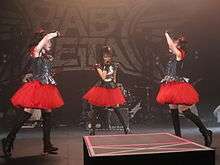The Sekhmet Hypothesis
The Sekhmet Hypothesis was first published in book form in 1995 by Iain Spence.[1] It suggested a possible link between the emergence of youth cultural symbols in relation to the 11-year solar cycles. The hypothesis was published again in 1997 in the journal Towards 2012[2] and covered in 1999, in Sleazenation magazine.[3]

Origins of the hypothesis
The origins of the hypothesis can be traced back to Robert Anton Wilson's book, Prometheus Rising, in which Wilson makes a singular correlation between the symbol of the flower child with the mood of friendly weakness.[4] Spence extended the comment into a study of various youth archetypes and linked in their behaviour to the four atavistic life scripts. The idea of linking pop culture to the solar cycles had been influenced from remarks made by Peter J. Carroll, in his book, Psychonaut.[5] Sekhmet is the Egyptian goddess of the sun.
Influence on comic book mythology
The author Grant Morrison later incorporated the idea into his Invisibles comic book series (1994–2000)[6] and his New X-Men comic book series (2001–2004).[7][8][9][10] Morrison has discussed his own views on the hypothesis in his book, Supergods (2011)[11] citing the topic as an influence on his X-Men graphic novel, Riot at Xavier's.[12] The story's lead character, Kid Omega, develops hostile strength tendencies which run out of control with dire consequences for his school.
Robert Salkowitz discusses the Sekhmet hypothesis in Comic-Con and the Business of Pop Culture, in which he questions Morrison's take on the hypothesis suggesting instead that the Strauss-Howe generational theory may explain deeper moods within pop culture.[13]
The origins of the life scripts
The life scripts relate to each other with the following dialogue:[14]
Friendly Weakness - I'm not okay, you're okayHostile Weakness - I'm not okay, you're not okay
Friendly Strength - I'm okay, you're okay
Hostile Strength - I'm okay, you're not okay
A diversified and holistic guide to the four life scripts was first introduced by Dr. Timothy Leary and three of his colleagues in 1951.[15] Leary suggested there were balanced, healthy forms of behaviour in relation to each of the life scripts and extreme, unhealthy forms of behaviour in relation to each of the scripts.[16][17] By the late 1960s psychologists such as Eric Berne,[18] Thomas Harris[19] and Claude Steiner[20] had changed Leary's holistic guide to one which favoured Friendly Strength over all the other scripts.
The four life scripts in relation to atavistic youth trends


By 2000, Spence had dismissed the solar side of the hypothesis, suggesting it had no scientific basis. He demonstrated how he believed the dates of solar maximum did not correlate with any heightened activity of youth culture.[21] However, he continued with the study of the four life scripts and their possible relationship to cultural youth trends.
The hypothesis suggests that the flower children of the sixties and the mellow side of reggae culture presents a collective mood of "friendly weakness" while punk culture and certain aspects of rap culture present an archetype of 'hostile weakness'. In the late eighties and nineties, rave culture along with early drum and bass supposedly presents a mood based mainly on 'friendly strength'.[22] The hypothesis suggests that most people are not hard wired to any particular life script and likewise young people are generally fluid enough to move between different pop trends with ease and some humour. Grunge for example is viewed as an atavistic hybrid, drawing on elements of both punk and hippie culture.[23]
The social symbolism of the hypothesis is also compared to the archetypal symbolism of Ezekiel's quaternity in the Christian Bible.[23] Ezekiel is said to have had a vision of the winged man (angel), the bull, the lion and the eagle. The same quaternity was later incorporated into illuminated manuscripts such as the Book of Kells. Spence has corresponded flower power and late reggae culture (Bob Marley, cannabis use, dub, dreadlocks) to the gentle angel; the rebellious mood of early rap and punk culture to the sullen bull and the leonine strength of drum and bass and rave culture to the proud lion.[23]
Grant Morrison and Iain Spence have split views on the subject of hostile strength played out through youth culture. Morrison suggests that the trend has come and gone with the film The Matrix (1999) along with commanding symbolism in the nu metal scene. Spence meanwhile suggests that the mood is yet to materialise within pop culture as a major trend but acknowledges that hostile strength symbolism has already emerged through the more commanding aspects of hip hop, gabber and metal sub-cultures. He has criticised Morrison's reference to The Matrix in relation to the hypothesis suggesting the film is not related to any specific youth trend.[23] Morrison already has a link to the film having influenced the story with his mythology of The Invisibles.[24][25][26][27]
The sequential integration of the life scripts


The hypothesis suggests that teenagers recapitulate infancy and childhood through pop culture. This self-referencing process supposedly leads to the manifestation of social symbols. Spence proposes that the life scripts start in infancy from the state of friendly weakness, an idea already proposed by Thomas Harris in his book, I'm OK, You're OK in 1970.[28]
Thomas Harris had split from Eric Berne's view that the scripts start from the stage of Friendly Strength.[29] There is still some argument as to the sequence and timing of the scripts.[30] Spence has proposed the life scripts evolve in the sequence of friendly weakness (at birth), hostile weakness (infancy), friendly strength and then lastly the commanding behaviour of hostile strength, some time in late childhood. Unlike Harris and Berne, Spence argues that hostile strength does not have to be "demonised or criminalised" as a mood, claiming that it is only one part of a balanced quaternity of behaviour.[31] In this respect he has returned to Leary's view of approaching the life scripts from a holistic perspective. Timothy Leary himself has also commented on the relationship between infancy and atavistic pop trends.[32] Other writers such as Jon Savage have applied the same view to punk culture.[33] Spence also draws on children's fiction to illustrate the "four timeless scripts" referring for example to the four main characters in The Wind in the Willows and the four children in The Polar Express.[34]
The Hare Hypothesis
By 2000 Spence had rejected any scientific links to the hypothesis suggesting it might best be treated as a psychological puzzle or game. He rewrote a web-site version of his ideas as, The Hare Hypothesis in a move to keep the hypothesis playful and devoid of any solar connection.[23] Grant Morrison revived the original solar link in 2011 in his book Supergods but didn't offer any scientific evidence in support of his views.[35] He later referred to the prediction of fashion trends in his fictional Multiversity series in which the character, President Harley, is said to predict the future with a formula known as Algorithm 8.[36] The name Harley is generally thought to be derived from the hare.[37]
The Hare Hypothesis received a mixed reception on Ted Hope's web-site, Truly Free Film, where it was called, 'a fun piece of pop-cultural analysis'. The book was also criticised for having a 'loose Jungian nature'.[38]
References
- ↑ Spence, Iain (1995). The Sekhmet Hypothesis. Bast's Blend. ISBN 9780952536505.
- ↑ Spence, Iain (1997). "The Sekhmet Hypothesis". Towards 2012 (Part 3 Culture and Language). Unlimited Dream Company/Slab-O-Concrete. ISBN 189986606X. Retrieved March 14, 2014.
- ↑ Beale, Steve (1999). "1999". Sleazenation. Swinstead. ISSN 1742-5506.
- ↑ Wilson, Robert Anton (1983). Prometheus Rising. Falcon Press. p. 55. ISBN 9781561840564. 'She/He is self-critical, shy, timid, easily led, "spineless," and always looking for somebody to Take Charge and Give Orders. The unearthly Angel, or in modern symbolism, the Flower Child'.
- ↑ Carroll, Peter J (1987). Liber Null/Psychonaut. Weiser. ISBN 0877286396.
- ↑ Morrison, Grant (2002). The Invisibles, Volume 7, The Invisible Kingdom. Vertigo. pp. 31, 34, 192. ISBN 1-4012-0019-2.
- ↑ Morrison, Grant (2001). New X-Men: E is for Extinction. Marvel. p. 7. ISBN 0-7851-0811-4.
- ↑ Morrison, Grant (2002). New X-Men: Imperial. Marvel. p. 6. ISBN 0-7851-0887-4.
- ↑ "New X-Men#114 Annotations". Deep Space Transmissions. Retrieved March 8, 2014.
- ↑ "New X-Men#118 Annotations". Deep Space Transmissions. Retrieved March 8, 2014.
- ↑ Morrison, Grant (2011). Supergods - Our World in the Age of the Superhero. Random House. pp. 301 to 307. ISBN 9781400069125.
- ↑ Morrison, Grant (2011). Supergods - Our World in the Age of the Superhero. Random House. p. 357. ISBN 9781400069125. "It was the darkside of Spence's imperial youth Stormer generation..."
- ↑ Salkowitz, Robert (2012). Comic-Con and the Business of Pop Culture. McGraw Hill. pp. 72 to 73. ISBN 978-0071797023.
- ↑ Wilson, Robert Anton (1983). Prometheus Rising. Falcon Press. pp. 50 to 59. ISBN 9781561840564.
- ↑ Leary, Timothy; Freeman, Mervin; Ossorio, Abel; Coffey, Hubert (1951). The Interpersonal Dimension of Personality. Journal of Personality, Volume 20, Number 2. pp. 143–161.
- ↑ Leary, Timothy (1957). Interpersonal Diagnosis of Personality: A Functional Theory and Methodology for Personality Evaluation. The Ronald Press Company. ISBN 9781592447763.
- ↑ Wilson, Robert Anton (1983). Prometheus Rising. Falcon Press. p. 52. ISBN 9781561840564. 'For instance, a widely used psychological test in this country the Leary Interpersonal Analysis Grid (1957) divides the four quadrants into sixteen sub-quadrants and allows one to grade each in terms of moderate-to-excessive tendency to behave that way.'
- ↑ Berne, Eric (1975). What Do You Say After You Say Hello?. Corgi. ISBN 978-0552098069. Chapters 3 and 11.
- ↑ Harris, Thomas (1973). I'm OK – You're OK. Pan Books. p. 36 to 51. ISBN 0 330 23543 5.
- ↑ Steiner, Claude (1990). Scripts People Live:Transactional Analysis of Life Scripts. Grove Press. ISBN 978-0802132109. Chapters 6 to 12.
- ↑ Spence, Iain (2012). The Hare Hypothesis. Bast's Blend. ASIN B009E2YUJM. Chapter 1 - Does Society 'Dream' Youth Trends?
- ↑ Spence, Iain (2012). The Hare Hypothesis. Bast's Blend. ASIN B009E2YUJM. Chapter 2 - The Four Life Scripts.
- 1 2 3 4 5 Spence, Iain (2012). The Hare Hypothesis. Bast's Blend. ASIN B009E2YUJM.
- ↑ Shapira, Tom (2013). "What is The Matrix?". Curing the Postmodern Blues: Reading Grant Morrison and Chris Weston's The Filth in the 21st Century. Sequart Research & Literacy Organization. p. 84. ISBN 978-0578060767.
It's also an homage (or a rip off) of much of the content of The Invisibles.
- ↑ "Grant Morrison - Talking with Gods". Halo 8. 2010. Retrieved August 17, 2015. "I think The Matrix owes Grant Morrison everything..." Phil Jimenez.
- ↑ "Science Fiction's Greatest Stolen Ideas". io9. 2009. Retrieved June 29, 2015. "Someone who has a bit more standing to accuse The Matrix of copying is Grant Morrison, author of comics series The Invisibles" Charlie Jane Anders.
- ↑ "7 Classic Movies You Didnt Know Were Rip-offs". Cracked.com. 2011. Retrieved December 29, 2015. "The Wachowskis have never acknowledged The Invisibles as an influence, even though they had invited the comic's creator Grant Morrison to contribute a story for their website. Morrison -- who actually liked The Matrix -- says he "was told by people on the set that Invisibles books were passed around for visual reference."".
- ↑ Harris, Thomas (1973). I'm Ok - You're Ok. Pan Books. p. 42. ISBN 0 330 23543 5. 'I'm not ok - you're ok: this is the universal position of early childhood, being the infant's logical conclusion from the situation from birth and infancy.'
- ↑ Steiner, Claude (1974). Scripts People Live: Transactional Analysis of Life Scripts. Grove Press. p. 8 - 9. ISBN 9780802132109.
- ↑ Stewart, Ian; Jones, Vann (1987). TA Today – A New Introduction to Transactional Analysis. Lifespace Publishing. p. 118. ISBN 1 870244 00 1.
- ↑ Spence, Iain (2012). The Hare Hypothesis. Bast's Blend. ASIN B009E2YUJM. Chapter 5 - The Sequential Integration of the Four Life Scripts.
- ↑ Leary, Timothy (1994). Chaos and Cyberculture. Ronin. p. 99. ISBN 9780914171775.
- ↑ Savage, Jon (1991). England's Dreaming, Sex Pistols and Punk Rock. Faber and Faber. p. 374. ISBN 0 571 16791 8. 'On the legs were the bondage trousers of claustrophobia and babyish incapacity.'
- ↑ Spence, Iain (2012). The Hare Hypothesis. Bast's Blend. ASIN B009E2YUJM. Chapter 6 - The Four Humours: 'Recently the four life scripts have turned up each Christmas with the popularity of, The Polar Express. Lonely Boy presents the friendly weakness of a melancholic, gentle lamb; Know it All Kid is the angry complainer of hostile weakness; Hero Boy is the helpful, protective friendly strength and Hero Girl is the leading child of hostile strength'.
- ↑ "An Evening with Grant Morrison and Gerard Way". Meltdown Comics. September 12, 2011. Retrieved March 20, 2014. Grant Morrison interviewed by Gerard Way: contains discussion on the early Sekhmet hypothesis.
- ↑ Morrison, Grant; Quitely, Frank (2014). Multiversity – Pax Americana. DC Comics. p. 28.
- ↑ "Dictionary Reference". dictionary.reference.com. 2015. Retrieved January 4, 2015. 'The surname Harley is attested from mid-12c., literally "dweller at the hares' wood."'
- ↑ Charles Peirce (2014). "The Hare Hypothesis". Truly Free Film. Retrieved July 2, 2015.